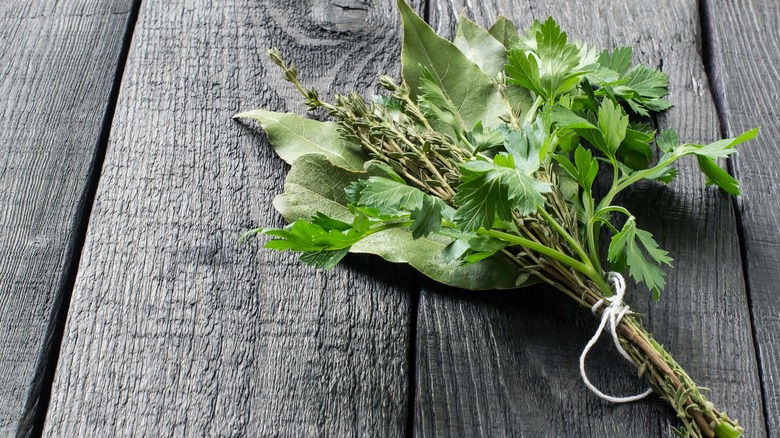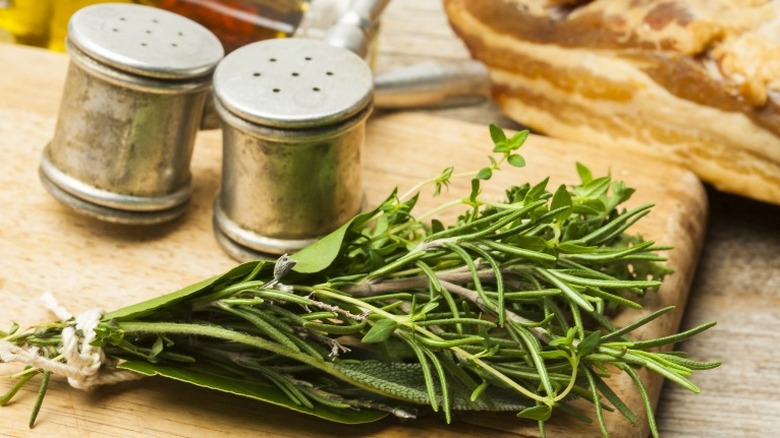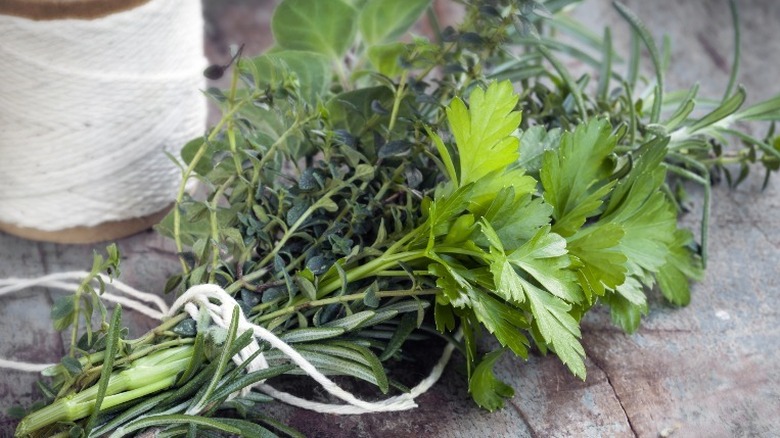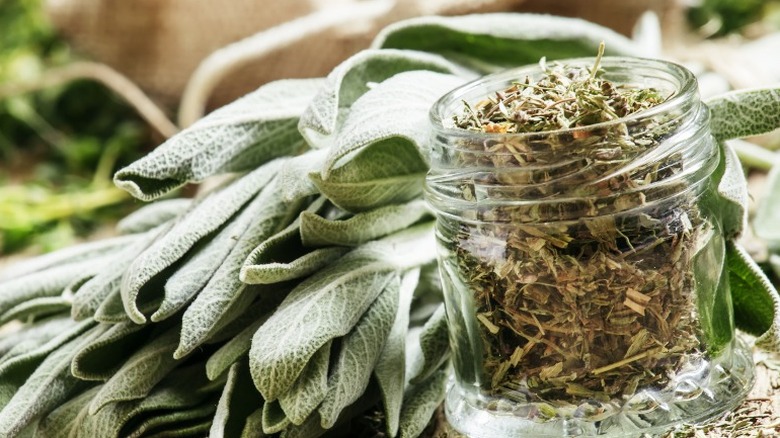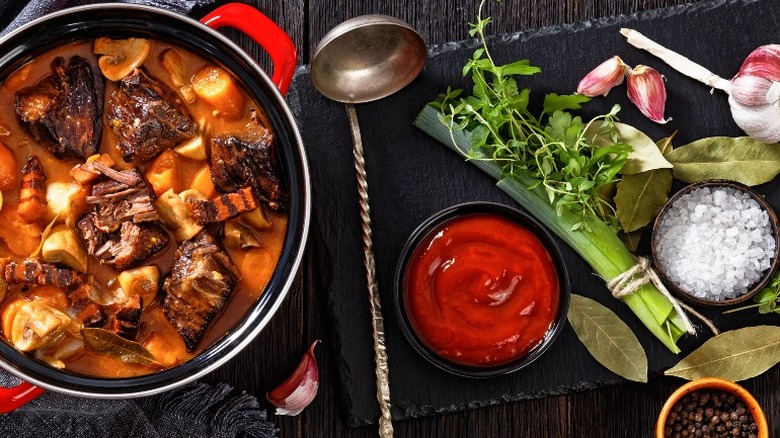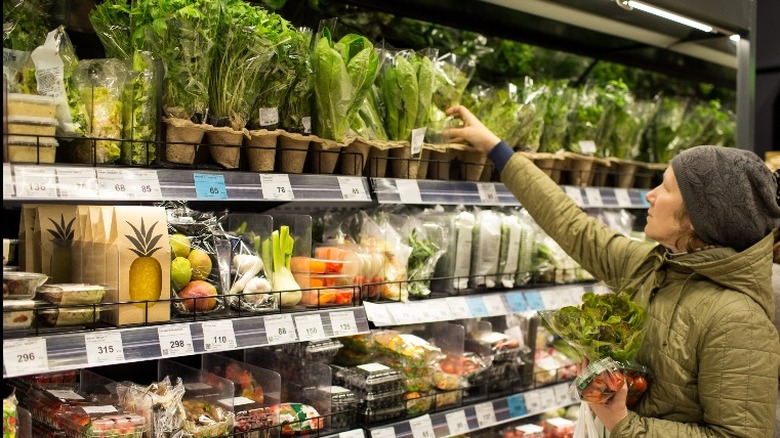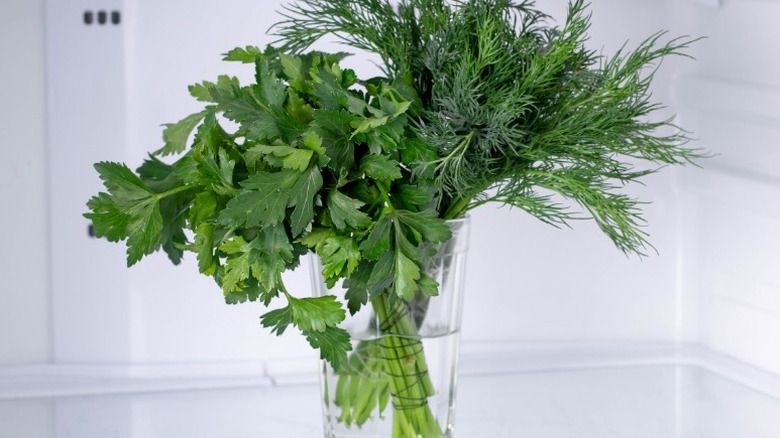What Exactly Is A Bouquet Garni, And Is It Worth Your Time?
At a glance, you might think that a bouquet garni is some fancy floral arrangement, and really, you aren't that far off. Okay, maybe it's not exactly a flower bouquet you would give someone you love, but a chef would undoubtedly consider it a gift of some sort — one that they'd happily toss in a stockpot or saucepan.
A bouquet garni, pronounced (boo-kay-Gahr-nee), means "garnished bouquet" and traditionally consists of a small bundle of fresh herbs, including parsley, thyme, and bay leaves. Classic combo aside, you have free reign in your kitchen, so feel free to use other herbs or aromatics. Remember, when you craft your little bundle, parsley is a non-exchangeable herb, and you should always add it. Considering parsley's clean and earthy flavor, it beautifully enhances all sorts of dishes.
A bouquet garni is usually bunched together and delicately encased in a cheesecloth or tied up with a strand of baker's twine. Using a bouquet will help with the overall flavor and presentation of your meal since you can easily add and remove the herbal bouquet. This is handy when you want to craft a smooth, even-toned sauce or broth without bothering to fish out tiny bits or pieces. Whether you're interested in learning more about French cuisine or you're always looking for new cooking techniques to adopt, a bouquet garni can be worthy of your time, depending on the dish you are making.
History and origins of the bouquet garni
Today we shuffle through our cupboards for cheesecloth and baker's twine when we need to assemble a bouquet garni, but the craft of this herbaceous bouquet has evolved over time. The bouquet garni first emerged in French cuisine in the 1600s to help flavor sauces, stocks, and other dishes (per CulinaryLore).
One of the first mentions of the bouquet garni is in Francois Pierre De La Varenne's cookbook, called "Le Cuisinier Francois." La Varenne's recipes and teachings helped establish a foundation of French cooking basics, like finding ways to complement flavors in a dish rather than masking them (per Cook's Info). That movement continued to evolve throughout the French Revolution and has since changed the way Americans eat today.
Adding and removing herbs with a bouquet was one way to help achieve the overall aesthetics and presentation of dishes which became important in the 1600s. The beauty of culinary arts has continued to develop significantly over time. Although you may be used to sprinkling herbs into your stew or soup towards the end of the cooking process, the infusion of flavors is heightened through long simmering times. Bundling the whole sprigs together and removing the herbs from a saucepan before serving is one excellent way to get the flavor without all the lumps.
How is a bouquet garni made?
You can make a bouquet garni in several ways depending on your tools or the recipe you plan to make. For example, twine works excellent for tying up hearty stems if you want to make a giant stew infused with earthy thyme and piney rosemary. Gather up all your herbs and use a five to seven-inch strand of culinary twine to tie it together tightly and throw it in your pot.
However, if you add a few peppercorns or tiny crushed herbs, cheesecloth will help keep your bouquet together. Cut a square piece of cheesecloth, then add your herbs, spices, and other choice aromatics. Pull the corners together, then use twine to tie the bouquet together and seal it shut. Some chefs like using leek leaves or a slice of raw bacon to wrap a bouquet garni. Not only does this help if you don't have cheesecloth on hand, but both serve as additional flavor boosters in whatever dish you make.
There are many other ways to package up a bouquet garni, even if you don't have cheesecloth or twine on hand. Cheesecloth boasts a gauze-like material that comes in handy in the kitchen, but luckily there are several easy alternatives for the tool. Cotton-constructed fine mesh bags, coffee filters, muslin blankets, and even medical gauze can all work to hold those precious herbaceous packs together.
Should you use fresh or dry herbs in a bouquet garni?
A traditional bouquet garni is always made with fresh herbs and contains parsley, thyme, and bay leaves. However, there is a lot you can do to go the nontraditional route, which includes using other fresh (or dry herbs).
The idea here is to use whatever herbs you have on hand that will lend well to your dish and help enhance flavor. For example, there are specific applications for using dried herbs in cooking rather than fresh herbs, and that's because they offer a bolder, more concentrated flavor than fresh. If you plan on making any sauce or braise with long simmering times, your best bet is to grab a jar of those budget-friendly dried herbs and have at it.
Keep in mind that if you plan to use dried herbs for your bouquet garni, you will most certainly need cheesecloth or similar material to hold those tiny bits and pieces together in a bundle. Place your combination of dried herbs over a few snipped layers of cheesecloth, then pinch the corners together and tie the ends tightly with twine.
How to cook with a bouquet garni
Cooking with a bouquet garni is similar across the board. You pack your selected herbal bouquet into your cheesecloth, add it to the hot dish and let the heat and time work its magic. Once the cooking time has ended, and you are ready to serve your meal, you remove the bouquet and toss it out.
One way to think about using a bouquet garni is to look at what you are cooking and your vision for the finished product. If you are hoping for a rich and flavorful sauce, free of lumps, then a bouquet garni will serve a great purpose. Large clumps of discolored and wilted greens don't add value to appearance or texture; it devalues the dish, so try a bouquet on your next sauce adventure.
You'll also appreciate the ease of a bouquet if you make light chicken stock. Not only will it lend to the overall flavor, but you'll love how effortless it is to remove the bouquet without sifting through all those aromatics and bones as much.
Combining a bouquet garni with other aromatics like mirepoix tastes incredible in dishes like red wine braised short ribs. A recipe like Anthony Bourdain's boeuf bourguignon, which uses aromatics like celery, garlic, and onion, also calls for several herbs and spices. Rather than fishing out the large pieces of herbs before serving, consider crafting a bouquet to cut down on effort when it is time to serve.
Where to buy a bouquet garni
Occasionally, you may run into a specialty market or grocery store that sells pre-assembled bouquet garni, but it's a rare addition to most produce sections. You will have better luck calling your local grocery store, getting in touch with someone from the produce section, and placing an order. However, they may need a little guidance from you if they aren't entirely familiar with bouquet garni.
Otherwise, you might find shelved versions of spice containers labeled "bouquet garni" but are, in reality, just plastic jars of blended herbs. If you already have all the herbs needed to assemble a bouquet, you are better off saving money and making one yourself.
Otherwise, if you're adamant about using an already-made version, then Amazon is a place you can find just that. The Terre Exotique French gourmet brand offers a pre-packaged variation composed of bay leaves, thyme, and rosemary. Morrisons also provides it in a jar, but both brands will cost you a pretty penny and won't come in fresh. Just another reason to craft one yourself.
What is the difference between a bouquet garni and a spice sachet?
The terms "bouquet garni" and "spice sachet" are often used interchangeably, which isn't necessarily far off when considering how similar they are. According to Auguste Escoffier School of Culinary Arts, a bouquet garni is defined as "a sachet of herbs, containing parsley, thyme, and bay leaf" that you add to soups and sauces and then remove before serving the dish. Similarly, a sachet is defined as "a small bag usually made of cheesecloth containing herbs and spices and is placed into soups, stews, stocks" and then removed before serving your meal.
Both are bundles of herbs you can add to a hot dish that cooks for a long period of time. The main difference is that a traditional bouquet always contains fresh parsley, thyme, and bay leaf and can be tied by twine or enveloped with cheesecloth. A sachet can have any herbs or spices and is always packaged in cheesecloth.
What is the difference between a bouquet garni and mirepoix?
Just like a bouquet garni is made up of aromatics used in cooking, a mirepoix serves the same purpose. Although the two work similarly to infuse your dish with lovely flavor, they are, in fact, different.
A classic mirepoix is a fragrant trio of vegetables that include roughly two parts onion, one part celery, and one part carrot. The three aromatic ingredients are often uniformly chopped up and then added to a dish. Typically you want to add larger cut mirepoix to recipes with long cooking times, like stew, and you can add smaller cut-up mirepoix to meals with quicker cooking times.
Similar to the bouquet garni, you'll find several recipes that call for mirepoix to be discarded toward the end of cooking. This is true for long-simmered recipes like stock and broth. Once the mirepoix has served its purpose, it should be fished out and discarded.
How to store a bouquet garni
If you have a lot of cooking to do in the upcoming days, you can build and store a few bouquets, so they are ready to go when you need them. However, in a traditional bouquet garni, you work with two different types of herbs, hard and soft, which typically need to be stored differently.
Bay leaf and thyme, which have hard, woody stems, should be wrapped in a lightly damp paper towel, then placed in an airtight container for best results. Soft-stemmed herbs, like parsley, store well when placed in a jar with a small amount of water. With that said, it's OK to build a bouquet garni a day or so in advance, but your parsley will only last for a few days.
If you do plan to prep and store in advance, construct your bouquet (or multiple bouquets), place them in an airtight container, and set them in your crisper drawer. You can alternatively prepare a bouquet with dried whole herbs, then store them in an airtight container in your pantry for up to two months. Dried herbs and spices only last a few months to a year before losing their oomph, so don't hold on to them for too long.
Considering you are adding a bouquet garni to a hot dish that will likely simmer for hours, the condition of your herbs doesn't have to be perfect. Feel free to build your bouquets, store them in an airtight container in your freezer and use them when needed.
